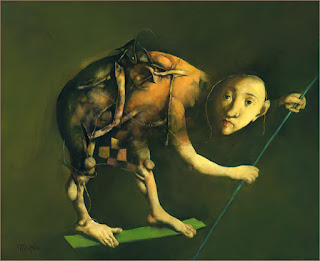All paintings in this post are by Georges Mazilu:
Georges Mazilu was born in Romany in 1951 and studied at the Grigorescu Art Institute in Bucharest, but in 1982, he fled Ceausescu's regime and was able to settle in France, where he remains. This tearing apart of the person that results from a forced exile from a beloved homeland, as well as from watching one's compatriots tear each other apart in an attempt to survive the dictatorship themselves--the feeling of a disjointed humanity, a not completely real existence in a not completely real place which isn't quite tailored for a creature just like yourself--that feeling is expressed with delicate beauty in Mazilu's work.
L'eventail, by Georges Mazilu
A curious thing happens to these creatures under Mazilu's gaze:
Le Cure, by Georges Mazilu
Above, the priest, who, with no hands or feet, has yet created of himself a way to move from here to there. His faith, I assume, makes him able to float above the ground, as if he were riding a bike.
His paintings seem to mix the Northern Renaissance style of clarity of light, of a certain vibrance of color, of large spaces lost to shadow, and of soft gazes just off to the side--moments of portraiture---with a surrealist balancing of limbs, of activities, of clothing, and ideas.
Le Reine des Myrtilles, by Georges Mazilu
Le Chat Verte, by Georges Mazilu
Here is
a painting entitled the Birdcatcher, where the catcher cannot catch with hands, but does so by providing a generous and apparently danger-free invitation, by growing an extra limb--not an arm, but a tree-limb, a branch--from his head. His colors match the coloring of the bird, which, as David Attenborough tells us in his fabulous videos, is a classic evolutionary technique to attracting birds as mates or as pollinators (for example a nut will have the same pattern as a female/male bird's chest, so the bird will crack it open to eat, and let fly the little seeds...)
In fact, perhaps it is through this attempt to connect with others that we become real:
La Femme au Renard, by Mazilu
See also the way we create:
Le nu academique: Here the painters are less solid than their creation, the model of flesh who walks towards us, almost real, more like "us" than her creators. We create, and then our creations create...and we become whole, alive...
or
L'ange du pelerin: the Pilgrim's Angel, who, being necessary for journey, has not just wings--homemade ones, it seems--, but comes naturally seated (for a feeling of rest) and also has the propeller on her head, perhaps for those with wanderlust who can't (for whatever reason) physically travel, and so must do it via their own heads (imagination).
Le Poupee Fleurie
Le Surfeur
Monument pour Picasso
Discovered via Form is Void: http://thombeau.blogspot.com/
.jpeg)
.jpeg)
.jpeg)
.jpeg)

.jpeg)




.jpeg)




















